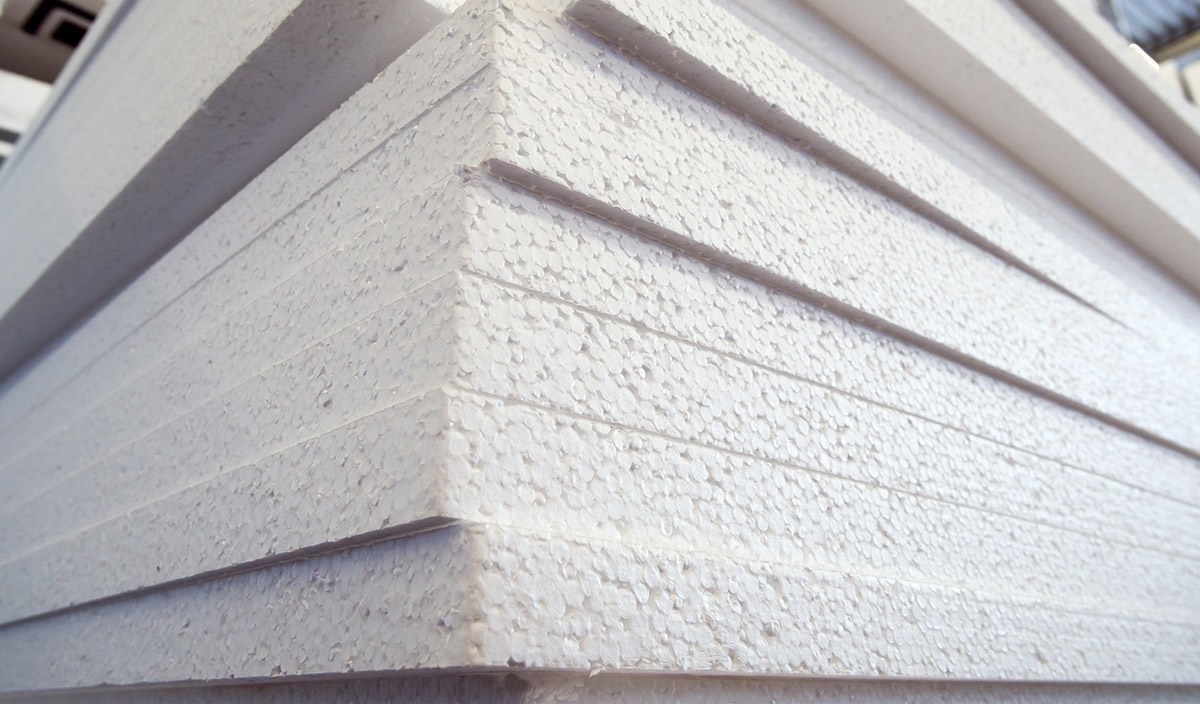
Expanded Polystyrene (EPS) foam is typically a white thermoplastic material with closed pores which is obtained from petroleum through the polymerization of styrene monomer. There are also grey or black products for which the grains are processed specially to reflect the long wave radiation.
In the EPS products made by inflating and fusing polystyrene grains, the gas used for obtaining the foam by inflating the grains is pentane. Being an organic component, pentane allows for the formation of many small pores within the grains, then it is replaced by air in a vey short time during and following production. Released pentane gas transforms into CO2 and water vapor (H2O) which are already present in the atmosphere. After pentane is released, still air is trapped by a great number of small, closed porous cells (3 to 6 billion cells in 1 m3 EPS according to the density) within the material. The material consists of still air by 98% and polystyrene by 2%.
The material is supplied as small grained raw material, then undergoes preliminary inflation. In the meantime, the pentane gas within the grains is replaced by air, and desired material density is obtained in this phase to a great extent. Then, the expanded grains allowed to rest in special silos are molded, fused by means of water vapor and gain the specific properties of the material. As a result of grain fusion, there is a continuous mass of honeycomb shaped polygons fused without voids. The following steps of production vary according to the area of use of the material (i.e. for thermal insulation or packaging).
Still air is known to be the most economic, environmentally friendly and perfect thermal insulation material. The superior thermal insulation properties of EPS are ensured by the still air within a great number of grains. Being one of the few best thermal insulation materials of the world, EPS is the only material which provides the same performance more economically than other thermal insulation materials used in our country.
This material is used as protective packaging for many products due to its flexible structure, impact absorption property and mechanical strength, and it prevents the packaged products from being damaged. Furthermore, special types of EPS are used for food packaging due to its thermal insulation and protection properties.
The other reason for being affordable despite its superior technical properties is that its production is not energy-intensive. In addition to effective mechanical strength, replacing the inflation gas with air in a very short time provides the product with stable performance during its useful life. Its thickness and thermal conductivity do not increase, mechanical properties do not change and other properties do not deteriorate over time.
EPS is produced in desired densities according to the area of use. As its properties can be modified by density as desired, it does not cause material waste and unnecessary cost increases. The production density is 15 to 30 kg/m3 for thermal insulation, and 20 to 100 kg/m3 for packaging material. As finished product, EPS has the properties of being lightweight, easy to process and able to be used with other materials for making composite products.
In addition to all these properties, EPS is an environmentally friendly material because it is 100% recyclable and does not contain any substance harmful to the atmosphere or ozone layer. Moreover, it is not harmful to human health, and special types of EPS can even be used in food packaging.
EPS products are intensively used in the thermal and sound insulation of buildings as sheet, pipes or preformed elements as well as in the packaging industry. From using as wall material for building walls to insulating cold storages, constructing roads in cold regions, reinforcing floors, making life buoys and life jackets, etc., EPS products have a limitless area of use in countless applications where lightness, strength, ability to be formed and applied easily and low thermal conductivity are important.